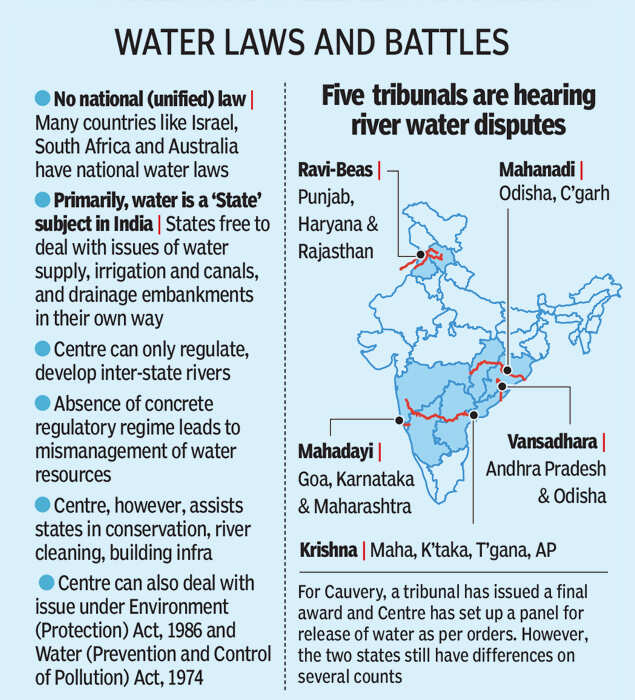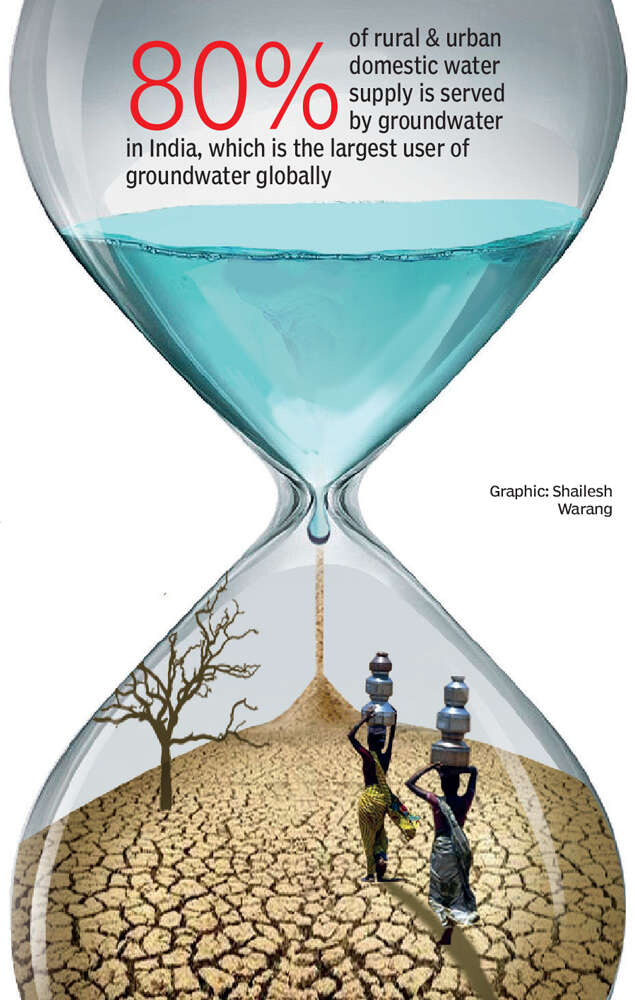The New National Water Policy (NWP)
Context
-
In November 2019, the Ministry of Jal Shakti had set up a committee to draft the new National Water Policy (NWP). This was the first time that the government asked a committee of independent experts to draft the policy. Over a period of one year, the committee received 124 submissions by state and central governments, academics and practitioners. The NWP is based on the striking consensus that emerged through these wide-ranging deliberations.
About National Water Policy (NWP)
- The policy recognises limits to endlessly increasing water supply and proposes a shift towards demand management.
- Irrigation consumes 80-90 per cent of India’s water, most of which is used by rice, wheat and sugarcane. Without a radical change in this pattern of water demand, the basic water needs of millions of people cannot be met.

Source: Times of India - Thus, crop diversification is the single most important step in resolving India’s water crisis.
- Irrigation consumes 80-90 per cent of India’s water, most of which is used by rice, wheat and sugarcane. Without a radical change in this pattern of water demand, the basic water needs of millions of people cannot be met.
- The policy suggests diversifying public procurement operations to include nutri-cereals, pulses and oilseeds.
- This would incentivise farmers to diversify their cropping patterns, resulting in huge savings of water.
- The largest outlets for these procured crops are the Integrated Child Development Services, the mid-day meal scheme and the public distribution system. Creating this link would also help address the crisis of malnutrition and diabetes, given the superior nutritional profile of these crops.
- Reduce-Recycle-Reuse has been proposed as the basic mantra of integrated urban water supply and wastewater management, with treatment of sewage and eco-restoration of urban river stretches, as far as possible through decentralised wastewater management.
- All non-potable use, such as flushing, fire protection, vehicle washing must mandatorily shift to treated wastewater.
- Within supply-side options, the NWP points to trillions of litres stored in big dams, which are still not reaching farmers and explains how irrigated area could be greatly expanded at very low cost by deploying pressurised closed conveyance pipelines, combined with Supervisory Control and Data Acquisition (SCADA) systems and pressurised micro-irrigation.
- The NWP places major emphasis on supply of water through “nature-based solutions” such as the rejuvenation of catchment areas, to be incentivised through compensation for eco-system services.
- Specially curated “blue-green infrastructure” such as rain gardens and bio-swales, restored rivers with wet meadows, wetlands constructed for bio-remediation, urban parks, permeable pavements, green roofs etc are proposed for urban areas.
- The NWP gives the highest priority to sustainable and equitable management of groundwater.
- Participatory groundwater management is the key. Information on aquifer boundaries, water storage capacities and flows provided in a user-friendly manner to stakeholders, designated as custodians of their aquifers, would enable them to develop protocols for effective management of groundwater.
- While acknowledging their economic role, the NWP accords river protection and revitalisation prior and primary importance.
- Steps to restore river flows include: Re-vegetation of catchments, regulation of groundwater extraction, river-bed pumping and mining of sand and boulders.
- The NWP outlines a process to draft a Rights of Rivers Act, including their right to flow, to meander and to meet the sea.
Key Suggestions of National Water Policy (NWP)
- The new NWP considers water quality as the most serious un-addressed issue in India today.

Source: Times of India - It proposes that every water ministry, at the Centre and states, include a water quality department.
- The policy advocates adoption of state-of-the-art, low-cost, low-energy, eco-sensitive technologies for sewage treatment.
- Widespread use of reverse osmosis has led to huge water wastage and adverse impact on water quality. The policy wants RO units to be discouraged if the total dissolved solids count in water is less than 500mg/L.
- It suggests a task force on emerging water contaminants to better understand and tackle the threats they are likely to pose.
- The policy makes radical suggestions for reforming governance of water, which suffers from three kinds of “hydro-schizophrenia”: That between irrigation and drinking water, surface and groundwater, as also water and wastewater.
- The NWP also suggests the creation of a unified multi-disciplinary, multi-stakeholder National Water Commission (NWC), which would become an exemplar for states to follow.
- Government water departments include professionals predominantly from civil engineering, hydrology and hydrogeology.
- Without experts in water management, social mobilisation, agronomy, soil science, hydrometeorology, public health, river ecology and ecological economics, solutions to India’s complex water problems will remain elusive.
- Since systems such as water are greater than the sum of their constituent parts, solving water problems requires understanding whole systems, deploying multi-disciplinary teams and a trans-disciplinary approach.
Conclusion
- Since wisdom on water is not the exclusive preserve of any one section of society, governments should build enduring partnerships with primary stakeholders of water, who must become an integral part of the NWC and its counterparts in the states. The indigenous knowledge of our people, with a long history of water management, is an invaluable intellectual resource that must be fully leveraged.
Back to basics
- Water is primarily a state subject in India, with each state free to deal with issues linked to supply, distribution and storage on its own unless the river happens to flow into a neighbouring region. For inter-state channels, the law allows the Centre to mediate or assist states to keep them clean and expand infrastructure.
- “Water being constitutionally a ‘State’ subject under ‘Entry 17’ can still be legislated centrally through a framework central law since ‘Entry 17’ is subject to ‘Entry 56’ of the ‘Union’ list that deals with Inter-State rivers and river valleys.
Geography Current Affairs UPSC 2022 : Click Here
Governance Current Affairs UPSC 2022 : Click Here
Visit Abhiyan PEDIA (One of the Most Followed / Recommended) for UPSC Revisions: Click Here
IAS Abhiyan is now on Telegram: Click on the Below link to Join our Channels to stay Updated
IAS Abhiyan Official: Click Here to Join
For UPSC Mains Value Edition (Facts, Quotes, Best Practices, Case Studies): Click Here to Join
